Trekking in Mongolia: Our Guide to the Top Places
Nick and Dariece from Goats on the Road camp, trek, and fly-fish their way through the rolling hills and rushing rivers of Mongolia's steppe. Find out how to plan and where to go.
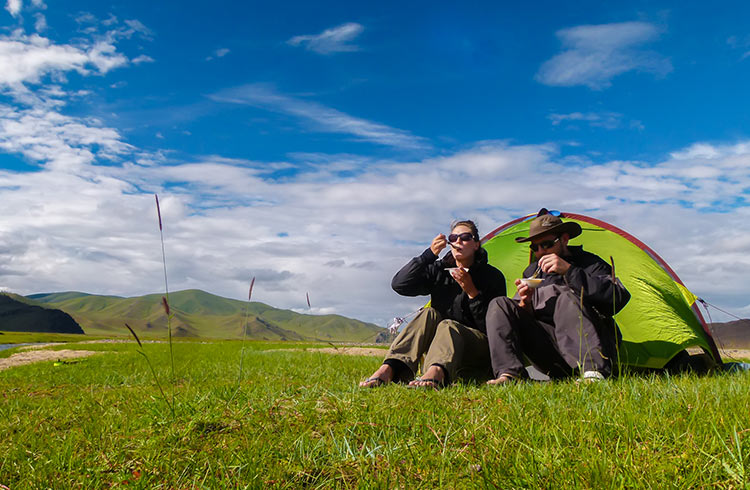 Photo © Goats on the Road
Photo © Goats on the Road
- Camping and fishing along the Chuluut River
- Meeting Mongolian nomads
- Horse trekking in Mongolia
- Trip notes
- Great trekking areas
- Suggested packing list
Camping and fishing along the Chuulut River
Nick and I boarded the Trans-Mongolian Train in Beijing, China, bound for Ulaanbaatar, Mongolia. This was the moment we had been waiting for, and while we were ecstatic about the upcoming travels, we hoped our travel planning was sufficient for the adventure we were about to embark on.
We had planned the trip six months earlier in our apartment in China, with Google Maps open on a laptop, as we tried to create our own trekking route and search for a river to trek beside. We both know how to fish, had been on a few trekking trips, and love camping.
The river we were hoping to find needed to have a sum (town) at the beginning and end of our trek, it needed to travel through flat terrain, and have plenty of fish, so we could fly fish for fun, and for dinner (we would carry backup food in case we weren't successful with our rods). We wanted to be far enough away from the much-visited sites, yet be close enough to local nomads, in case of an emergency.
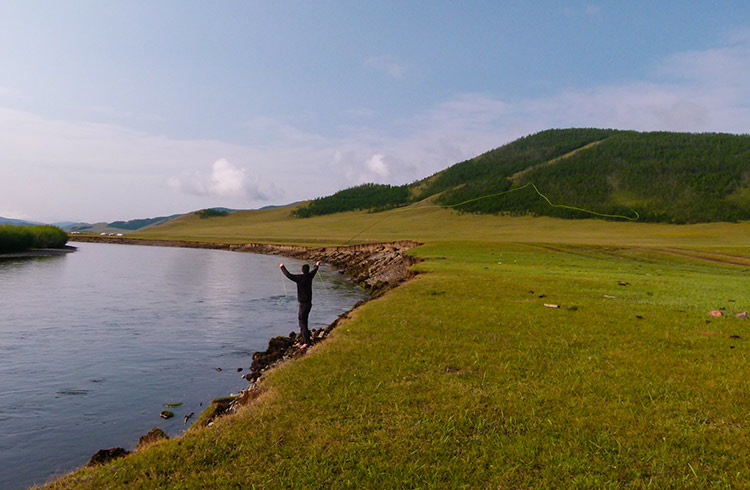
Eventually, we found “our” river and route. We decided to trek 75mi (120km), between Chuluut Sum and Tariat, across the steppe (large area of flat grassland), along the Chuluut River, completing it in eight days, camping and fishing along the way.
We trekked in August, in the Arkhangai Aimag area, which is known for its pretty landscapes, rushing rivers, and pastures filled with livestock, with Terkhiin Tsagaan Nuur (White Lake), our final destination. Following the Chuluut River, we camped each night under the stars, fished, endured endless rains and flooding of the steppe, were invited into numerous gers (portable, yurts) for food and drink, and even taught a Mongolian man how to fly fish. As we were completely self-sufficient when it came to our food, water, and shelter, we carried a sleeping bag, waterproof tent, stove, and dehydrated/freeze-dried meals during our trek.
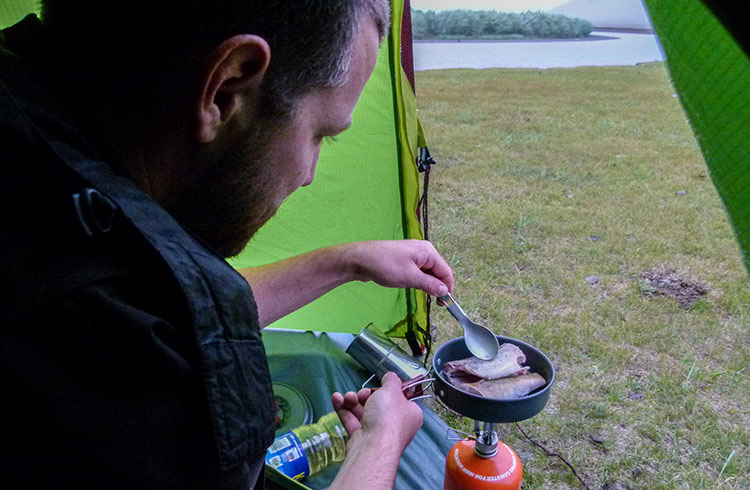
Each morning we would wake to the sound of dogs barking at a nearby ger, or from the sun beating onto the tent, and breakfasted on cereal bars and nuts. We’d break camp at around 8.30am and walk until the afternoon, covering around 12mi (20km) a day.
We’d set up camp near the river, as it was our source of food, drink and our laundry. Nick would cast his rod into the river, while I would boil water from the river for our freeze-dried meals, which were sometimes supplemented with fish. It was lovely to read my book with no sounds other than the fishing reel.
Each evening we were asleep by 7:30pm, tired from a day of trekking. It was just the two of us, with the occasional ger and a few yaks in the distance.
Meeting Mongolian nomads
One of the best parts of our trek was meeting local herders and nomads along the way. When camping out on the steppe, we met Mongolians every day who would ride their horses to our camp to meet the strange foreigners who chose to walk rather than ride a horse. Each time they brought us gifts of cheese, yogurt, biscuits, meat or wood for the fire.
We were invited into a traditional ger, and saw how nomadic Mongolians lived, learned how the ger is built and tried the local food.
If you travel as part of a tour you will get to stay in a ger, with nomads as your roommates or neighbors. The Orkhon Valley in Central Mongolia is a great area to join a tour and enjoy a ger homestay.
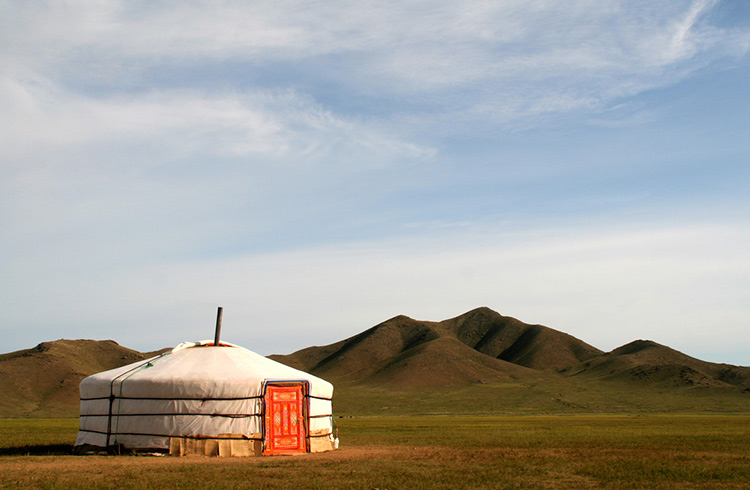
Another option is to stay in a tourist ger camp, where you get to enjoy the luxuries of a shower and flushing toilet. There are camps at White Lake, Terelj National Park, Altai Tavan Bogd National Park and the Gobi Desert, among others.
Horse trekking in Mongolia
While trekking on horseback is a good option if you’re not overly fit (make sure that the saddles are Russian, as Mongolian saddles are incredibly hard, with little padding), we wanted to walk.
Mongolians are proud of their strong, stocky horses, and Mongols are born to ride. Horses are a huge part of Mongolian culture, and should be ridden at least once. Horse tours are available around the country, with day trips available in the Gobi Desert (among other places).
Do your research before committing to a tour; find out how the horses are treated and whether the company is highly rated by other travelers. Stepperiders offers multi-day horse treks, plus a solo trekking program where visitors spend a week learning about horses, horse-riding, and Mongolian customs. At the end of the program, you can rent your own horses (one for riding, and one for your gear), to embark on a solo journey.
Trip notes
The weather in Mongolia is freezing in winter (it can reach -40°F/C at night) and warm in the summer (temperatures can reach as high as 104°F/40°C), can rain at any time of the year, and during June and July, you can expect a lot of flies.
Always dress for the weather, and have warm clothes packed just in case.
Plan an exit strategy in case of emergency. Figure out if your phone will work where you’re going, and maybe choose a trekking route that has a road nearby. Carry a topographical map, GPS, and a compass and learn how to use all of them before you head out on your adventure. Pack more food than you think you will need and make sure you will have a water source nearby for the entire route.
Great trekking areas
The Altai
The Altai in western Mongolia is unlike any other part of the country; rather than the usual vibrant, green steppe, you’ll find snow-capped, jagged mountain ranges. The trekking here is for those who are in good physical shape, and are looking for an intrepid mountaineering trip filled with culture and wildlife. It’s best to join a group tour if you’re going to tackle the Altai.
Lake Khövsgöl
There are numerous trekking options here. While the lake itself is a popular tourist destination, not many people opt to trek around the lake, or to follow one of the rivers which lead into this body of water. A popular route is from Lake Khövsgöl to Darkhad, which is around 77mi (125km).
Khangai Mountains and Otgontenger
This is an easier area for hiking, and is also a popular spot for camping. Highlights include Tsagaan Nuur (White Lake), Otgontenger Uul (tallest peak in the Khangai Mountains), and Dayan Davaa (a sacred mountain pass).
8 Lakes
A picturesque area in Central Mongolia. This is a great spot for intermediate hikers, with trails listed as “moderate”. The area has eight lakes and numerous rivers, and is an excellent spot for camping.
Suggested packing list
Note: if you’re carrying everything on your back, make sure the items you purchase are lightweight.
- Sleeping bag – it gets cold in Mongolia, even during the summer months.
- Waterproof tent
- A stove – we used the MSR Pocket Rocket
- Fuel canister – 16oz lasted our eight-day trek, only cooking dinner and not boiling drinking water
- A mess kit
- Bug spray, sunscreen and a hat – the flies and the sun can be intense at times
- Moist towelettes – unless you are going to bathe in the river you’ll want these to “shower” with at the end of a trekking day.
- Multi-tool/knife
- Duct tape – for fixing holes in shoes or in the tent, or anything else that might arise.
- First-aid kit – with gauze, plasters, antibiotics, anti-inflammatories, bismuth, scissors, safety pins, antihistamines, and ibuprofen.
- Flashlight / headlamp
- GPS / compass / map – you don’t want to get lost…
- Water purifier / steripen / water purification tablets – you can drink the river water provided there isn’t any livestock around. Sterilize the water just to be sure.
- Food - I recommend dehydrated/freeze-dried meals when trekking because they are lightweight, filled with protein and all you do is add water. Smoked meat, cheese, nuts and seeds, chocolate bars, instant noodles and instant mashed potatoes are also good. Make sure your meals are high in calories and protein. Having a hot drink is always nice at night or in the morning – bring some tea, coffee or hot chocolate.
- Heeding the advice of locals before you head out is also something I highly recommend doing.
Happy trekking!
Related articles
Simple and flexible travel insurance
You can buy at home or while traveling, and claim online from anywhere in the world. With 150+ adventure activities covered and 24/7 emergency assistance.
Get a quote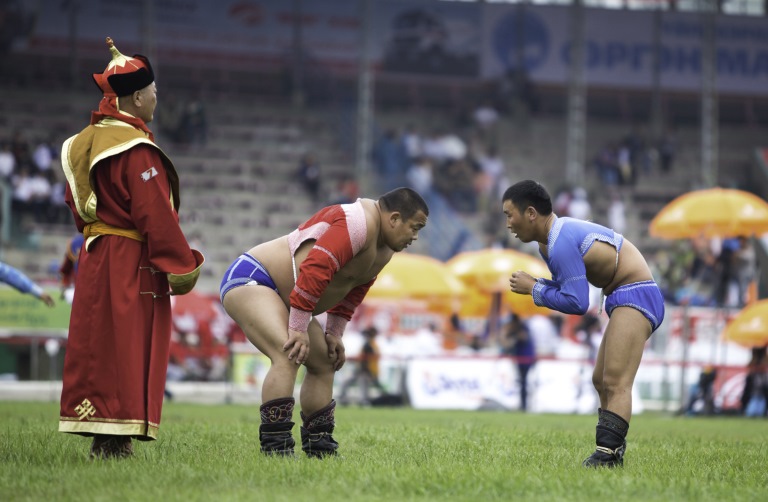
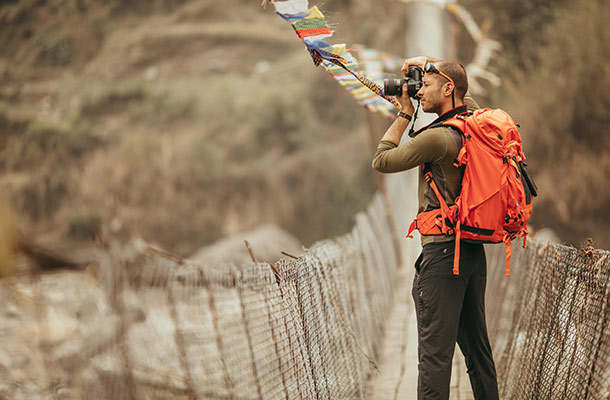
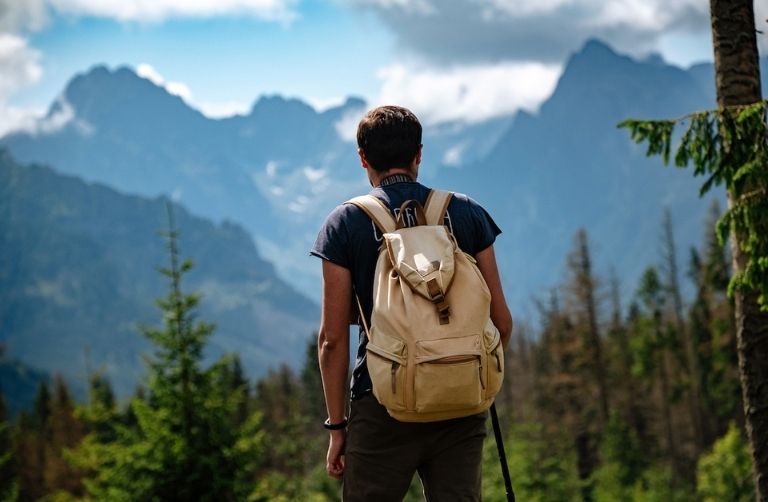
1 Comment
I spent a bit more than a month in Mongolia and I loved it! The Gobi is just incredible.
If you are going there, I wrote a few articles that might help you:
How to Get From Ulaanbaatar to Karakorum (Mongolia) for 7 Dollars: http://www.outofyourcomfortzone.net/how-to-get-from-ulaanbaatar-to-karakorum-mongolia-for-7-dollars/
How to Get from China (Beijing) to Mongolia (Ulaanbaatar) for Less than 45 USD (2016 UPDATED): http://www.outofyourcomfortzone.net/how-to-get-from-china-beijing-to-mongolia-ulaanbaatar-for-less-than-45-usd/
25 Interesting Things I Learned While Traveling in Mongolia: http://www.outofyourcomfortzone.net/25-interesting-things-i-learned-while-traveling-in-mongolia/